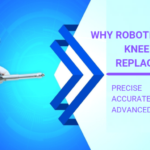NAVIO Robotics-assisted Surgical System
Total knee replacement surgery is a conventional approach to alleviating the pain and be short of function resulting from arthritis of the knee. While conventional knee replacement surgery is highly successful, incidences of improperly installed replacement parts are not rare. To improve outcomes, robotic-assisted total knee replacement surgery has recently become available and has been shown to be very effective for partial knee replacement surgery Meet the NAVIO Surgical System, a robotics-assisted knee surgery platform that adds an extra layer of pre-surgical arrangement and improved accuracy for partial and total knee replacement procedures.
NAVIO Robotics-assisted knee replacement surgery
Your knee replacement surgery is unique, based on your knee structure and the implant used. Designed to help make sure your knee replacement is positioned and aligned correctly, surgeons use the NAVIO Surgical System. Proper positioning of the implant is important because implant alignment is a critical factor in determining how long your implant may last.
NAVIO system benefits
The NAVIO system offers two important profit for people undergoing a knee replacement procedure. First, it helps your surgeon create a highly individualized plan that is specific to the unique shape and motion of your knee. Traditional planning may require CT scans, a series of images similar to x-rays that shows cross-sections of your knee. While other robotic-assisted platforms require CT scans, the NAVIO system works without them, meaning you are not exposed to the potentially injurious radiation experienced with this type of imaging. The second benefit is robotic support. This combination of advanced technology is designed to help your surgeon and may result in more accuracy, giving you better long-term outcomes. The NAVIO system is used for both partial and total knee replacement, which are definitely different procedures. Here’s a bit more information on how the NAVIO system is used in these surgeries
Partial knee replacement
In a partial knee replacement, your supporting tissue and ligaments that help stabilize your knee are spared and only the damaged portion of the knee is replaced. This means that healthy cartilage and bone remain intact to help your knee joint move smoothly with the prosthetic implant. Patients with osteoarthritis in only one area of their knee may be candidates for partial knee replacement.
Robotics-assisted planning and partial knee surgical procedure
- Using the NAVIO system, your surgeon creates a 3D representation of the unique shapes and profiles of your knee without the need for a pre-operative CT scan.
- Using all of this information your surgeon can then determine the correct size and position of the implant. Implant size and position are critical to knee alignment and stability.
- Next, your surgeon uses robotic assistance of NAVIO to physically remove only the damaged bone, preparing the site for the prosthesis, before placing and adjusting your partial knee implant.
Robotics-assisted planning, and total knee surgery guidance
Just as in the partial knee procedure described above, your surgeon creates a 3D representation of the unique anatomy of your knee without the need of a pre-operative CT scan. Your surgeon uses your knee anatomy information to determine the correct size and position of the implant and creates a surgery plan unique to your anatomy.

 Next Post
Next Post